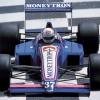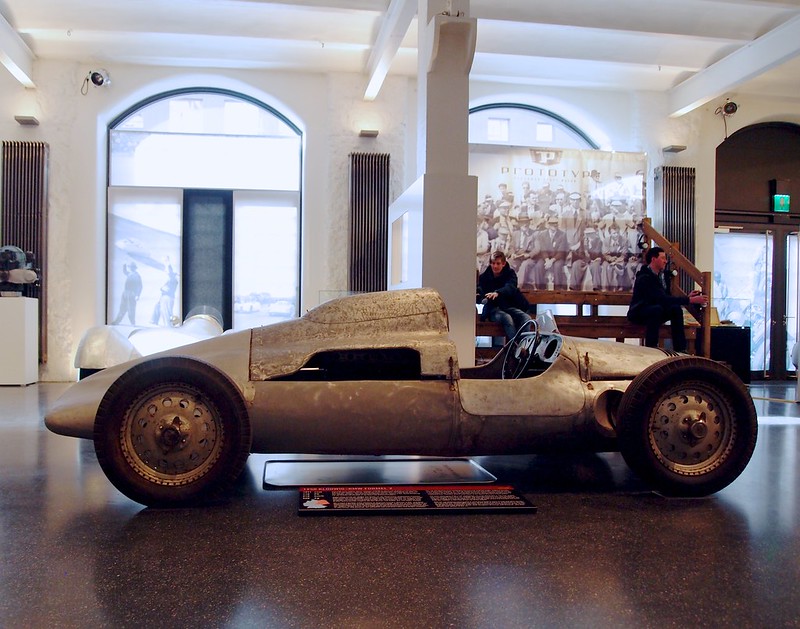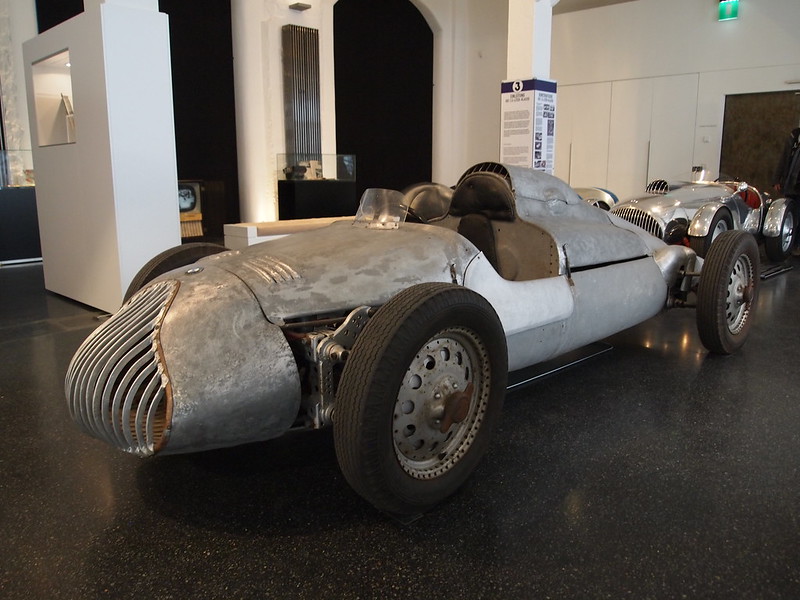Now to the 1953 Grand Prix, starting with a real big-banger
#21 Hans Stuck, AFM "Model 1950" - Bristol: The senior of German post-war drivers, whose star as one of Auto Union Silver Arrows pilot had already seemed on the descent in the later 1930ies. But obviously he himself feeled different about this and experiences a second or maybe third summer of his career after the war. In this his gerat popularity helped him to always meet the right people to open doors where for others they remained locked. For example, from reading his autobiography, back in 1929/30 when he had won the European Mountain Championship for Austro Daimler, the Austrians rewarded him with some kind of nationality 'honoris causa'. To this he remembered after the war, when German drivers were without representation in the FIA and thus were not allowed to start outside their country. So, while resident in Grainau/Germany (albeit very close to the Austrian border) and always with German citzenship, Stuck took up negotiations with the Austrian clubs and authorities to get his door-opener to the world, the new Austria´s first racing license! Thus in 1947 he was able to join Piero Dusio´s Cisitalia 'circus', and he also took his little monoposto to Hockenheim to humiliate the supercharged pre-war Grand Prix monsters, that had somehow survived the war. Being also known as the 'Bergkönig' (mountain king) he drove the Cisitalia to a couple of successes in Swiss and Italian hillclimbs and also into a fine second place at the 1948 Voiturette race at Berne, but then in 1949 suddenly found himself without a drive again, when Dusio´s company had collapsed over the development costs of their Porsche-designed Tipo 360 Grand Prix car. he found salvation in person of Alexander von Falkenhausen, who at that time was trying to establish his AFM make as an alternative to Veritas in the race car business, and recognized the chance that offered to him to have his products promoted to an international audience by the popular Stuck. So while he could have made hopes himself for the German championship with his brand-new Formula 2 monoposto, Falkenhausen did not hesitate to entrust the car to Stuck for the participation in the Monza Grand Prix, one of the major Formula 2 races at that time. So, while disguised as Austrian, this was the first start of a German driver in a German-built car after the war, and notorious jump-starter Stuck did his best to attract attention, using the torque of his car´s BMW engine to shoot into the lead from all the suprised works Ferraris right at the start. In the following slipstream battle he could keep up with the leaders, before he fell behind due to mechanical problems to be finally classified seventh. Nevertheless it had been a promising start and back home Stuck underlined his honoric title as 'Bergkönig' to win the 'Mountain Grand Prix' at the Schauinsland and shortly after also the important Maloja hillclimb in Switzerland. On the circuits it went less fine, for - with the exception of a respectable fourth place at Lausanne and a somehwat surprising third on the highspeed Grenzlandring - Stuck´s car was usually plagued by mechanical failures, a prize all German teams had to pay for still being at least economically bound to second-hand materials. This was also the fate when he returned to Monza in 1950, where he gave another impressive show by winning his heat in front of nobody else than the great Juan Manuel Fangio, but then had to retire with bearing damage from the final. Trying to find a way out of the trap, Stuck came to terms with Richard Küchen, who had already produced motorcycle engines in the 1920ies and had set up a new factory at Ingolstadt in 1946. Following the 'multi-cylinder' fashion of the time Küchen had developed a V8 dohc engine, considered the lightest and most modern racing engine in Germany at the time. For this Stuck ordered another monoposto chassis from Falkenhausen and brought the new car to the Schauinsland hillclimb in 1950. A fourth place here foloowed by a third at the Solitude (behind the new Veritas Meteors of Kling and Lang) proved the car´s basic performance, but at the German Grand Prix Formula 2 race Stuck disappointed the expecting home crowd like alle the other German starters when he was disqualified for being push-started after he had had to stop because of the accelerator pedal had stuck. Similar problems happened to him at the Garda lake race and again at Marseilles early in 1951, where he together with von Falkenhausen (now in his own car again) was also the first German driver to start in a race in France after the war. It turned out, that while the V8 engine was powerful, it lacked from some basic design faults and neither Stuck nor Küchen did have the means and resources for a necessary development. So Stuck, who was also talking about having been victim of some sabotage acts in 1950, could only make some minor modifications, like a stronger battery and the exchange for the complicated-to-handle eight motorcycle carburetors by Weber double carburetors. So the 1951 season became again a sequence of ups and downs, with a third place at the Munich-Riem airfield followed by three retirmenets in a row on his already traditional trip to Italy (Monza, Genua, Caracalla), then a stroke of light again ( class win and 2nd overall at the Susa - Mt Cenis hillclimb and overall win at Aosta - San Bernardino), a probably little bit disappointing second to Pietsch at the Schauinsland, an unspectacular 8th at Erlen/Switzerland and then finally a very surprising outright win on the highspeed Grenzlandring, where the engine lasted despite in permanent full-throttle to keep Stuck´s open-wheel monoposto ahead of all the other streamliners in the race. Inspired by this and also by the promotion of Formula 2 to the highest motorsport level in 1952, Stuck seems to have even intensivated his international ambitions in 1952, so that he was hardly to be seen at home at all. Nevertheless his starts at Syracuse, Torino, Pau, Marseille, Berne (Swiss GP and World Championship round) more or less did all end with the same result - retirement (or in the case of Marseilles at the back of the result table), so from around mid-season he turned his attention back to his own real domain, the hillclimbs, where in the comparatively short runs reliability dod not count so much and he could play out the advantages of his car and engine, winning the Formula 2 classes at Chiusaforte - Sella Nevea and Aosta - San Bernardino. Interestingly, while still staying absent from the circuits in West Germany, he found a new playground for a while in the Easten part of the country, where he was clearly the big fish in the pond. Yet, around late summer he seemingly had enough from the AFM and the Küchen engine and was looking for something else to drive again. he came to a deal with Rudi Fischer, who ran two Ferraris under the Swiss Ecurie Espadon banner, to drive the team´s older V12 Ferrari in the Italian Grand Prix. Alas, the effort ended in non-qualification followed by a retirement at the Avus race and so Stuck had again to look for a new idea for 1953. He pulled the Küchen-AFM out of the garage again and made a trip to the Silverstone International Trophy, perhaps with his major interest in this journey being the purchase of a Bristol engine. As this had been basically a development from the BMW 328 it gave no problems to get it installed in the AFM chassis and with the British access to state-of-the-art parts and materials he certainly promised himself much better reliability. Nevertheless, the engine had already proved to be no real match to the Ferraris and Maseratis in 1952 when installed in the Cooper chassis, it probably still needed more maintenance than Stuck was able to give. Thus he retired from the Eifelrennen and very disappointingly also on the first lap of the German Grand Prix, and even on the East German circuits had now regularily to give way for Edgar Barth in the EMW works. Even worse, Stuck also obviously started to loose ground on the mountains, so after a final attempt at the Italian Grand Prix, where he ended up near the back of the classement, he finally saw the time to say farewell to the circuits and the car - to once again start over his career driving for BMW to become German hillclimb champion in 1960.


















